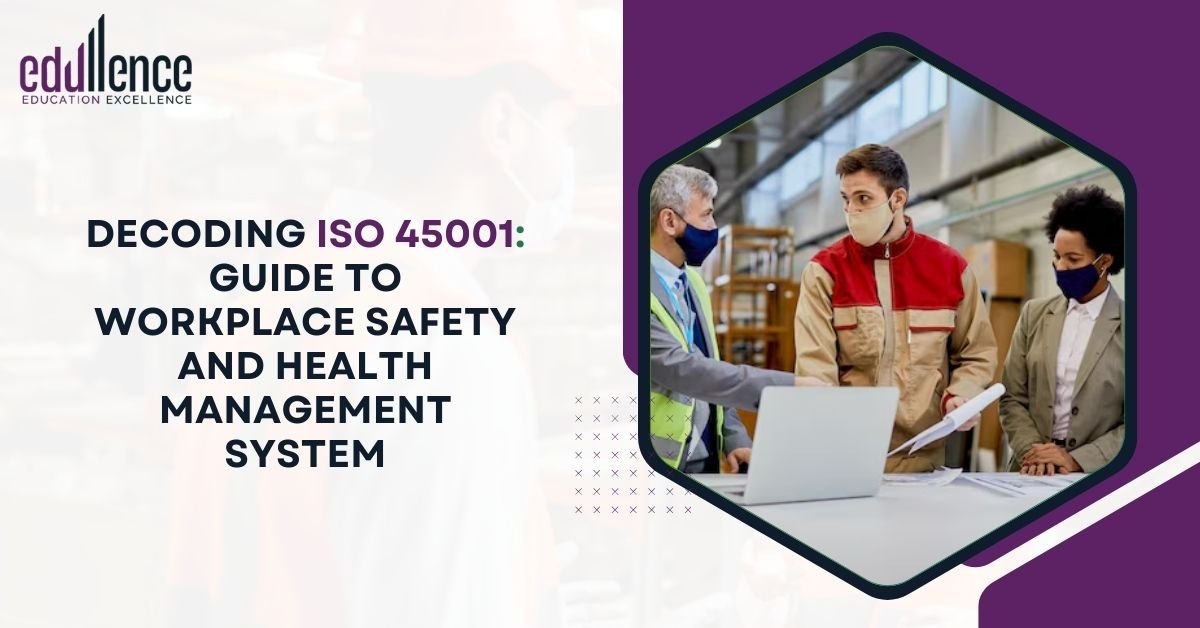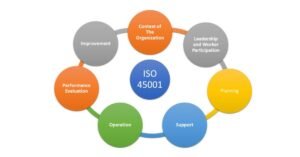In today’s ever-growing global preserve environment, the workforce is always at work throughout the day and their well-being is very valuable. It is on the increase and it obviously must make sense that companies are having to achieve improved standards in occupational health and safety. ISO 45001 is a newly developed standard that has been developed internationally. The purpose of establishing this standard is to help organizations increase the protection of their people at workplaces by controlling risks related to occupational health and safety. In this blog, some of the elements of the ISO 45001 standard will be discussed as its relevance to the organizations especially those who may be on the docket to attend the Occupational Health and Safety Management Systems Foundation Training Course
What is ISO 45001?
ISO 14001 is the international standard that deals with Environmental Management while ISO 45001 is the Occupational Health and Safety Management standard. The International Standards Organization developed the undertaking to help organizations address unsafe workplace factors, aiming to create safe environments for workers. Since this is a universal standard, large and small organizations, sectors, and local locations can adopt its implementation. Hence, this paper forms a basis for an effective way of improving workplace safety.
Why is ISO 45001 so important?
Safety is not only a question of legal responsibility, but also it is the most important resource of any organization: its people. Due to that fact, ISO 45001 will provide systemization in the management of opportunities and threats by minimizing risks and hazards linked to workplace accident occurrence. Application of this standard will enable corporate responsibility for protecting the employees and may improve the image of the company by boosting morale toward raising the productivity of employees.
Organizations can develop and effectively operate their systems according to ISO 45001, meeting various legal and regulatory requirements while avoiding fines and penalties.It is worth mentioning here that while scoring these business strategy goals, the organization would find this immensely crucial to have this Occupational Health and Safety Management Systems Foundation Training Course leading to ISO 45001 to prove to the stakeholders that the company values safety and quality.
Key Elements of ISO 45001
ISO 45001 follows the PDCA model for its management system to develop and support continual improvement.
- Context of Organization: The factors influencing OHSMS need to be identified. Employee Focus: It would facilitate an organization to take into consideration the needs and expectations of workers along with the other stakeholders in ensuring they are representative of organizational strategy.
- Leadership and Participation of Workers: These are the imperative factors relating to the aspect of implementation of the management system. Works carried out by ISO 45001 outline the leadership role of top management on OHSMS and the involvement of workers at all levels of the hierarchy. It ensures the integration of safety practices into all activities the organization undertakes.
- Planning: Planning is a major process through which occupational health and safety hazards are identified and brought under control. Planning addresses the identification of risks, assessing risks, and controlling risks. Other considerations of the planning process entail the establishment of goals and objectives aimed at improving the OHSMS while the latter acts as a tool used in the evaluation of the degree of conformance to the OHSMS.
- Support: these are things that must be done to meet the operation and maintenance of OHSMS. This involves providing adequate training, and communication besides documentation. The employers ensure the workers’ competence to perform work safely.
- Operation: This includes the established and created central concept of implementing plans and activities. Some activities involved entail control of operational hazards, emergency planning, and setting conventions that ensure safety in the organization.
- Performance Evaluation: However, to guarantee that the OHSMS is efficient, organizations require constantly assessing and evaluating their performance. This includes internal assessments such as those of internal control, reporting of incidents, and satisfaction of objectives and targets.
- Improvement: The concept of continual improvement applies to ISO 45001. Business entities must examine for improvement areas and correct faults when they are applicable. This is useful in avoiding some occurrences while enforcing the right safety culture in the organization..
Benefits of ISO 45001 Implementation
Implementing ISO 45001 brings several benefits. Here are some of the critical benefits:
- Improved safety among employees: ISO 45001 works in the direction of a reduction in hazards and risks at workplaces. Hence, it will offer accident-free workplace safety to prevent daily accidents or injuries. Legal Compliances: It helps make sure about the legal and regulatory compliances of any organization, thereby having the effect of preventing possible fines and legal cases.
- Improved Reputation: ISO 45001’s good business practices may have a positive impact on the whole organization, a good image is built with its customers and workers, as well as stakeholders.
- Improved Productivity: Hazard-free working conditions boost morale among workers; and reduce instances of absenteeism resulting in high productivity.
- Cost Savings: In minimizing workplace hazards, there will be an equivalent return on compensation regarding legal fees and lost time.
Role of Occupational Health and Safety Management Systems Foundation Training
Any organization planning to implement the ISO 45001 standard should undergo training in an Occupational Health and Safety Management Systems Foundation Training Course. This will ensure that the organization can appreciate the requirements of the standard and how to design, implement, and maintain an OHSMS. The course outlines concepts, principles, and practices fundamental to ISO 45001 and develops in participants relevant competencies to enable and enhance workplace safety improvement.
Conclusion
ISO 45001 serves as a powerful and essential tool for organizations with existing OHS management systems. It assists in the protection of the employees while the organization fulfills legal requirements; and leads to enhanced corporate results. The benefits of the Occupational Health and Safety Management Systems Foundation Training Course include immediate return on investment, from certification to transforming your organization into a safer workplace. Edullence Education Excellence thus gears its operations significantly toward providing superior training that enables organizations to attain their security goal and success.

